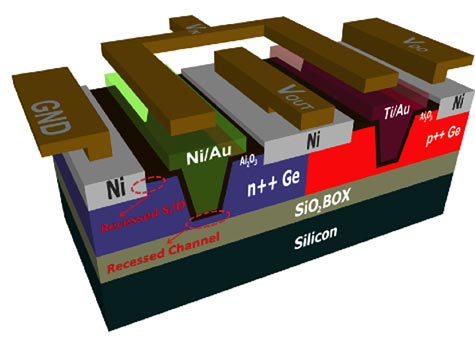Germanium comes home to Purdue for semiconductor milestone

This graphic depicts a new electronic device created at Purdue that uses germanium as the semiconductor instead of silicon. Germanium is one material being considered to replace silicon in future chips because it could enable the industry to make smaller transistors and more compact integrated circuits. (Purdue University image)
The team has created the first modern germanium circuit – a complementary metal–oxide–semiconductor (CMOS) device – using germanium as the semiconductor instead of silicon.
“Bell Labs created the first transistor, but the semiconductor crystal made of purified germanium was provided by Purdue physicists,” said Peide “Peter” Ye, a Purdue professor of electrical and computer engineering.
Germanium was superseded by silicon as the semiconductor of choice for commercial CMOS technology. However, the industry will soon reach the limit as to how small silicon transistors can be made, threatening future advances. Germanium is one material being considered to replace silicon because it could enable the industry to make smaller transistors and more compact integrated circuits, Ye said.
Compared to silicon, germanium also is said to have a “higher mobility” for electrons and electron “holes,” a trait that makes for ultra-fast circuits.
In new findings, Purdue researchers show how to use germanium to produce two types of transistors needed for CMOS electronic devices. The material had previously been limited to “P-type” transistors. The findings show how to use the material also to make “N-type” transistors. Because both types of transistors are needed for CMOS circuits, the findings point to possible applications for germanium in computers and electronics, he said.
Findings will be detailed in two papers being presented during the 2014 IEEE International Electron Devices Meeting on Dec. 15-17 in San Francisco. One paper was authored by Ye and graduate students Heng Wu, Nathan Conrad and Wei Luo, the same authors of the second paper together with graduate students Mengwei Si, Jingyun Zhang and Hong Zhou.
The material has properties that make it difficult to create an N-type contact with low electrical resistance for good current flow. However, the germanium is doped, or impregnated with impurities that alter its properties. The areas containing the most impurities have the lowest resistance. The researchers showed how to etch away the top layer of germanium, exposing the most heavily doped portion, which provides a good contact.
The etching creates recessed channels, which serve as gates needed for CMOS transistors to switch on and off. Findings show the fundamental part of the circuit, called the inverter, is the best-performing non-silicon inverter demonstrated so far, Ye said.
The research, based at the Birck Nanotechnology Center in Purdue's Discovery Park, are funded in part by the Semiconductor Research Corp.
Writer: Emil Venere, 765-494-4709, venere@purdue.edu
Source: Peide Ye, 765-494-7611, yep@purdue.edu
Note to Journalists: Electronic copies of the research papers are available from Emil Venere, Purdue News Service, at 765-494-4709, venere@purdue.edu
ABSTRACT
First Experimental Demonstration of Ge CMOS Circuits
Heng Wu, Nathan Conrad, Wei Luo, and Peide D. Ye*
School of Electrical and Computer Engineering, Purdue University
*Tel: 1-765-494-7611, Fax: 1-765-496-6443, Email: yep@purdue.edu
We report the first experimental demonstration of Ge CMOS circuits, based on a novel recessed channel and S/D technique. Aggressively scaled non-Si CMOS logic devices with channel lengths (Lch) from 500 to 20 nm, channel thicknesses (Tch) of 25 and 15 nm, EOTs of 4.5 and 3 nm and a small width ratio (Wn:Wp=1.2) are realized on a Ge-on-insulator (GeOI) substrate. The CMOS inverters have high voltage gain of up to 36 V/V, which is the best value among all of the non-Si CMOS results by the standard top-down approach. Scalability studies on Ge CMOS inverters down to 20 nm are carried out for the first time. NAND and NOR logic gates are also investigated.
Media Contact
All latest news from the category: Power and Electrical Engineering
This topic covers issues related to energy generation, conversion, transportation and consumption and how the industry is addressing the challenge of energy efficiency in general.
innovations-report provides in-depth and informative reports and articles on subjects ranging from wind energy, fuel cell technology, solar energy, geothermal energy, petroleum, gas, nuclear engineering, alternative energy and energy efficiency to fusion, hydrogen and superconductor technologies.
Newest articles

Bringing bio-inspired robots to life
Nebraska researcher Eric Markvicka gets NSF CAREER Award to pursue manufacture of novel materials for soft robotics and stretchable electronics. Engineers are increasingly eager to develop robots that mimic the…

Bella moths use poison to attract mates
Scientists are closer to finding out how. Pyrrolizidine alkaloids are as bitter and toxic as they are hard to pronounce. They’re produced by several different types of plants and are…

AI tool creates ‘synthetic’ images of cells
…for enhanced microscopy analysis. Observing individual cells through microscopes can reveal a range of important cell biological phenomena that frequently play a role in human diseases, but the process of…





















